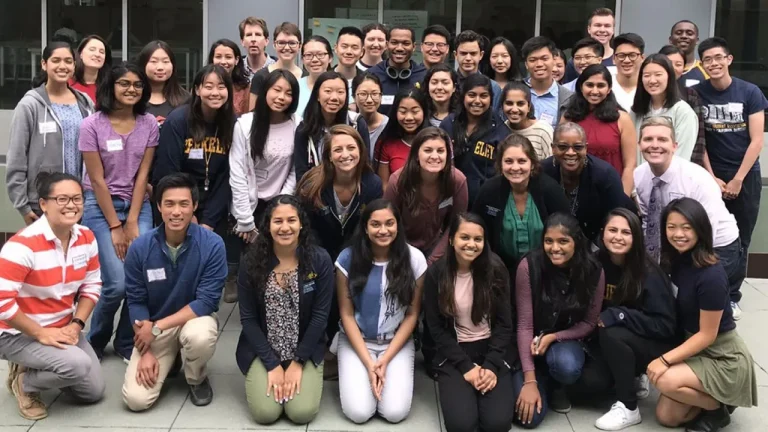The Best Computer Science Courses To Take In High School
With technology advancing at lightning speed, computer science skills are in high demand across practically every industry. If you’re short on time, here’s a quick answer to your question: The best computer science courses to take in high school are intro to computer science, AP computer science principles, AP computer science A, data structures and algorithms, web development, and robotics.
In this approximately 3000 word article, we will provide an in-depth look at the most valuable computer science courses for high school students to take if they are interested in pursuing a career in technology or computer science.
Intro to Computer Science
Intro to Computer Science is the foundation course for any student interested in pursuing a career in computer science. This course provides a comprehensive introduction to the world of programming, computing concepts, and computational thinking.
It equips students with the fundamental knowledge and skills necessary to excel in more advanced computer science courses.
Learning Programming Basics
One of the key components of an Intro to Computer Science course is learning the basics of programming. Students are introduced to popular programming languages such as Python, Java, or C++, and learn how to write code to solve problems and create simple programs.
They gain an understanding of programming syntax, variables, loops, and conditionals, which are essential building blocks for more complex programming concepts.
Several online platforms offer interactive tutorials and exercises for learning programming basics. Codecademy and Khan Academy are great resources that provide step-by-step guidance and hands-on practice.
These platforms make learning programming fun and engaging, with immediate feedback and interactive challenges to keep students motivated.
Understanding Computing Concepts
In addition to programming, an Intro to Computer Science course also covers important computing concepts. Students learn about the different components of a computer system, including hardware and software, and how they work together to execute programs.
They explore topics such as algorithms, data structures, and computer architecture, gaining a deeper understanding of how computers process and store information.
Websites like MIT OpenCourseWare and Coursera offer free or low-cost online courses that cover computing concepts in detail. These courses are taught by experts in the field and provide a comprehensive overview of the fundamental principles of computer science.
They often include video lectures, assignments, and quizzes to ensure a well-rounded learning experience.
Developing Computational Thinking Skills
An Intro to Computer Science course also focuses on developing computational thinking skills. This involves breaking down complex problems into smaller, more manageable parts and designing algorithms to solve them.
Students learn to think logically and analytically, applying problem-solving strategies to real-world scenarios.
Several studies have shown that computational thinking skills are not only valuable in the field of computer science but also have practical applications in other disciplines. The ability to analyze data, think critically, and solve problems efficiently is highly sought after in today’s job market.
For those interested in exploring computational thinking further, websites like Scratch and Code.org offer interactive platforms that allow students to develop their problem-solving skills through coding projects and puzzles.
These resources are designed to be accessible to beginners and provide a playful and engaging environment for learning.
AP Computer Science Principles
AP Computer Science Principles (AP CSP) is one of the best computer science courses to take in high school. It offers students a comprehensive introduction to the world of computer science and helps them develop essential computational thinking skills.
Applying Computational Thinking
In AP CSP, students learn how to think like a computer scientist and solve problems using computational thinking. They are exposed to real-world scenarios where they can apply algorithms, abstraction, and analyze data to find effective solutions.
This course encourages students to think logically and critically, preparing them for future careers in computer science or related fields.
Using Visual Block Coding
One of the unique aspects of AP CSP is the use of visual block coding. Instead of writing code in a traditional programming language, students use visual blocks to create programs. This approach makes coding more accessible and enjoyable for beginners, allowing them to focus on the logic and structure of their programs without getting overwhelmed by syntax errors.
It also enables students to quickly grasp fundamental programming concepts.
Creating Digital Artifacts
AP CSP encourages students to explore their creativity and apply their computational skills to create digital artifacts. These artifacts can be anything from interactive websites to mobile apps or even animations.
By completing hands-on projects, students gain practical experience in designing and implementing their ideas, fostering their innovation and problem-solving abilities.
Preparing for AP CSP Exam
AP CSP culminates with an exam that assesses students’ knowledge and skills in computer science principles. This exam consists of multiple-choice questions, a performance task, and an end-of-course exam.
Students who perform well on the exam may have the opportunity to earn college credit or advanced placement in computer science courses. It’s important for students to prepare thoroughly for the exam by practicing coding, reviewing course materials, and seeking additional resources or study guides.
Taking AP Computer Science Principles in high school is a great way for students to develop a strong foundation in computer science. It equips them with essential skills and knowledge that can open doors to exciting career opportunities in the technology industry.
To learn more about AP CSP and its benefits, visit College Board’s official website.
AP Computer Science A
One of the best computer science courses to take in high school is AP Computer Science A. This course offers students the opportunity to learn valuable programming skills and gain a solid foundation in computer science concepts.
Writing Programs in Java
One of the key components of AP Computer Science A is learning to write programs in Java. Java is a widely-used programming language in the industry and is known for its versatility and robustness. Students will learn how to write code to solve problems, create algorithms, and develop applications.
Through hands-on projects and assignments, they will gain proficiency in Java programming.
Learning Object-Oriented Programming
Another important aspect of AP Computer Science A is learning object-oriented programming (OOP). OOP is a programming paradigm that focuses on creating reusable code components called objects. This approach allows for modular and efficient code development.
Students will learn concepts such as classes, objects, inheritance, and polymorphism, which are fundamental to OOP.
Preparing for AP CSA Exam
AP Computer Science A culminates in an exam that tests students’ knowledge and skills in computer science. The exam covers a wide range of topics, including programming concepts, problem-solving, and algorithm development.
Students will have the opportunity to prepare for this exam through practice tests, review materials, and classroom instruction. A strong performance on the AP CSA exam can even earn students college credit.
It is worth mentioning that the College Board’s official website offers resources and sample questions to help students prepare for the AP CSA exam. These resources can be accessed at https://apstudents.collegeboard.org/courses/ap-computer-science-a.
Taking AP Computer Science A in high school not only provides students with practical programming skills but also exposes them to the foundations of computer science. This course can pave the way for future studies and careers in the field of technology.
So, if you’re interested in computer science and want to challenge yourself with a rigorous course, AP Computer Science A is definitely one to consider!
Data Structures and Algorithms
One of the most essential courses to take in high school computer science is Data Structures and Algorithms. This course focuses on how to organize and manipulate collections of data effectively. It introduces students to different data structures like arrays, linked lists, stacks, queues, and trees, and teaches them how to implement these structures using programming languages such as Python or Java.
Working with Collections of Data
In this course, students will learn how to work with collections of data, which are fundamental in computer science. They will understand the advantages and disadvantages of each data structure and gain hands-on experience in implementing and manipulating them.
For example, they will learn how to add, remove, and search for elements efficiently in an array or a linked list.
Writing Efficient Code
Another crucial aspect of this course is learning to write efficient code. Students will explore various algorithms that can solve problems in the most optimized way. They will understand concepts like time complexity and space complexity and how they affect the performance of their programs.
By analyzing and comparing different algorithms, students will develop the ability to choose the most suitable one for a given problem.
Solving Complex Problems Methodically
Data Structures and Algorithms also teaches students how to approach and solve complex problems methodically. They will learn problem-solving techniques like divide and conquer, recursion, and dynamic programming.
By breaking down challenging problems into smaller, more manageable subproblems, students will develop a systematic approach to problem-solving and enhance their critical thinking skills.
Taking a Data Structures and Algorithms course in high school provides a strong foundation for students interested in pursuing a career in computer science. It equips them with the necessary skills to design efficient algorithms, work with large datasets, and solve complex problems.
Websites like GeeksforGeeks and Coursera offer online resources and courses for further learning in this area.
Web Development
Web development is a highly sought-after skill in today’s digital world. With the increasing demand for websites and online applications, learning web development can open up a world of opportunities for high school students interested in computer science.
Here are some key areas to focus on when learning web development:
Building Websites from Scratch
Building websites from scratch is a great way for high school students to gain hands-on experience in web development. By starting with a blank canvas, students can learn the fundamentals of web design and coding.
They can experiment with different layouts, color schemes, and typography to create visually appealing and functional websites. This process allows students to understand the structure and components of a website, such as headers, footers, navigation menus, and content sections.
Learning HTML, CSS, and JavaScript
HTML, CSS, and JavaScript are the three core technologies used to create websites. HTML (Hypertext Markup Language) is used to structure the content of a web page, while CSS (Cascading Style Sheets) is used to define the visual appearance of the page.
JavaScript, on the other hand, is a programming language that adds interactivity and dynamic features to websites. High school students should focus on learning the basics of these languages, as they form the foundation of web development.
Creating Responsive UIs
In today’s mobile-first world, it is essential for websites to be responsive, meaning they can adapt to different screen sizes and devices. High school students should learn how to create responsive user interfaces (UIs) to ensure that their websites look and function well on smartphones, tablets, and desktop computers.
They can use CSS frameworks like Bootstrap or Foundation to easily create responsive designs and make their websites accessible to a wider audience.
Publishing Sites to the Web
Once high school students have built and designed their websites, they need to learn how to publish them to the web. This involves purchasing a domain name, setting up a web hosting account, and transferring the website files to the server.
Students can also learn about search engine optimization (SEO) techniques to improve their website’s visibility in search engine results. There are many online resources and tutorials available that guide students through the process of publishing websites to the web.
By learning web development in high school, students can gain valuable skills that can be applied in various industries. Whether they choose to pursue a career in web development or use their skills to enhance their personal projects, the knowledge gained from these courses will undoubtedly be beneficial in the digital age.
Robotics
Robotics is an exciting field that combines computer science, engineering, and technology. It offers high school students the opportunity to apply their coding skills in a physical and hands-on manner.
By participating in robotics courses, students can gain practical experience in designing, building, and programming robots.
Applying Coding Skills Physically
In robotics courses, students have the chance to take their coding skills to the next level by applying them to physical objects. They can program robots to perform specific tasks, such as navigating a maze or picking up objects.
This hands-on approach allows students to see the direct impact of their coding decisions and helps them understand how programming can be used to control real-world objects.
Building and Programming Robots
One of the key aspects of robotics courses is learning how to build and program robots. Students learn about the different components of a robot, such as motors, sensors, and actuators, and how to assemble them into a functional robot.
They also learn programming languages like Python or Arduino to control the robot’s movements and actions. By gaining these skills, students can become proficient in both hardware and software aspects of robotics.
Competing in Robotics Competitions
Many robotics courses offer the opportunity for students to participate in robotics competitions. These competitions allow students to showcase their skills and knowledge by designing and programming robots to complete specific tasks or challenges.
Participating in these competitions not only provides a fun and engaging experience but also helps students develop critical thinking, problem-solving, and teamwork skills.
According to FIRST Robotics Competition, students who participate in robotics competitions are 2.4 times more likely to show interest in STEM careers. This statistic highlights the impact that robotics courses can have on students’ future career paths.
Conclusion
Taking foundational computer science courses like intro to CS, AP CSP, and AP CSA along with more advanced classes like data structures, web development, and robotics will provide high school students with the skills and experience needed to thrive in a technology-driven world.
Whether pursuing higher education in CS or seeking a tech career directly after high school, these classes offer the best preparation.







